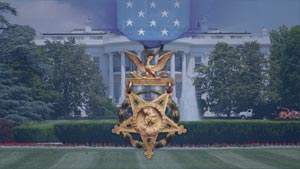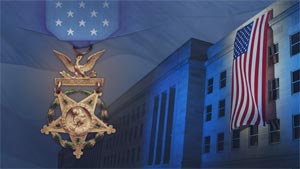MEDAL OF HONOR
Korean WarPrivate First Class Wataru Nakamura

hometown
Los Angeles, California
Enlistment date
April 1944
Military Occupation (MOS)
Infantryman (11B)
Unit
Company I, 38th Infantry Regiment, 2nd Infantry Division
Deployments
World War II, 1944 and Korea, 1950
Wataru Nakamura was born on Nov. 20, 1921, in Los Angeles, California, the second of seven children. After graduation from Thomas Jefferson High School, he went to San Francisco to work at a relative’s business to help support the family. When Executive Order 9066 was signed in 1942, which required Japanese Americans to live in internment camps, he rejoined his family, who were assigned to a relocation center in Rohwer, Arkansas. He enlisted in the Army in 1944. He was sent to Europe to serve with the 442nd Regiment (Company K). After being discharged, he lived in Chicago, Illinois, until he was called back to active duty in 1950.
 Wataru Nakamura (position unknown) poses with his siblings for a family photo in Los Angeles, California, 1932. Courtesy photo.
Wataru Nakamura (position unknown) poses with his siblings for a family photo in Los Angeles, California, 1932. Courtesy photo.
In May 1951, Pfc. Nakamura was serving with Company I, 3rd Battalion, 38th Infantry Regiment, 2nd Infantry Division, in Korea. At approximately 4:30 a.m. on May 18, 1951, Nakamura volunteered to check and repair a damaged communications line. Unaware that the enemy had infiltrated and captured heavily fortified friendly positions, he moved forward until he came under a withering hail of hostile fire. Disregarding his safety, he made a one-man assault, destroying a machine-gun and its crew with his carbine and bayonet and destroying two other enemy positions with grenades. When his ammunition was expended, he was forced to withdraw in the face of overwhelming odds. After falling back, he met a carrying party, briefed the officer in charge, replenished his ammunition and returned to engage the hostile force. Supported by rifle fire, he wiped out an enemy position and attacked the remaining bunker, killing one and wounding another enemy soldier before he was mortally wounded.
 Wataru Nakamura poses for a photo in San Francisco, California, 1941. Courtesy photo.
Wataru Nakamura poses for a photo in San Francisco, California, 1941. Courtesy photo.
The Battle
Courage under fire
May 18, 1951 | Vicinity of P'ungch'on-ni, Korea.

38th Infantry Regiment, 2nd Infantry Division
Distinctive unit insignia of the 38th Infantry Regiment, displaying the nickname The Rock of the Marne and the iconic blue and white of the 3rd Infantry Division. Read Full Unit History
Pfc. Wataru Nakamura distinguished himself by acts of gallantry and intrepidity above and beyond the call of duty while serving with Company I, 38th Infantry Regiment, 2nd Infantry Division, in the vicinity of P’ungch’on-ni, Korea on May 18, 1951. Around daybreak, Nakamura volunteered to check and repair a communications line between his platoon and the command post. As he made his way along the line, he was brought under fire from an enemy force that had surrounded friendly positions and were threatening to break the company defense lines.
Immediately, without regard for his own safety and without waiting for help, Nakamura rushed the enemy with a fixed bayonet and single-handedly destroyed a hostile machine gun nest and drove the enemy from several bunkers they had captured. When his ammunition was depleted, he withdrew under intense enemy fire. He then met an ammunition party ascending the hill. After quickly briefing the officer in charge, Nakamura rearmed himself and returned to the fight.
In a fierce charge, he killed three of the enemy in one bunker, then killed and seriously wounded another in the last enemy-held bunker. Continuing to press the attack, he was mortally wounded by an enemy grenade.
Nakamura’s extraordinary heroism and selflessness above and beyond the call of duty were in keeping with the highest traditions of military service and reflect great credit upon himself, his unit and the United States Army.
RELATED STORIES FROM ARMY.MIL
38th Infantry Regiment, 2nd Infantry Division

The regiment was organized in 1917 and took part in the French Campaigns of 1918 in the 3rd Division; its most remarkable feat being at Chateau Thierry on the Marne, July 15, where it broke the point of the German attack. This division is shown by the broken chevron, the rock and motto. The divisional insignia forms the base of the shield.
The 38th Infantry Regiment was constituted in May 1917 as a unit of the regular Army. In October 1917 it was assigned to the 3rd Division. Deploying with the 3rd Division to France, the regiment earned the nickname “Rock of the Marne” in July 1918 after it defeated a much larger German force attacking across the Marne River. The regiment participated in all subsequent major battles of the war. After occupation duty in Germany, the 38th returned to the United States in 1919. In 1939, the regiment was transferred to the 2nd Infantry Division, with whom it served in World War II and the Korean War.
The 2nd Infantry Division was constituted in 1917 as a unit of the regular Army and organized in France from units assigned to the American Expeditionary Forces, including a U.S. Marine Corps brigade. The 2nd Infantry Division fought in all of the major battles of 1918, such as Belleau Wood, Soissons, St. Mihiel and the Meuse-Argonne. After occupation duty in Germany, the 2nd Infantry Division moved to the United States in 1919, replacing the U.S. Marine Corps brigade with an Army brigade. Between the world wars, it tested the Triangular Infantry Division concept that the Army would use in World War II and the Korean War.
In 1943, it deployed to the United Kingdom, and then to France in June 1944. The 2nd Infantry Division fought from Normandy to Germany and played a vital role in the Battle of the Bulge in December 1944. Resuming the offensive, the division crossed the Rhine River in March 1945 and was in Czechoslovakia when Germany surrendered. The 2nd Infantry Division returned to the United States in July 1945 to prepare for the invasion of Japan, but the war ended before it could deploy. Instead, the division moved to Fort Lewis, Washington.
In July 1950, the 2nd Infantry Division became the first division sent from the United States to reinforce the Eighth Army in Korea. It helped hold the Pusan Perimeter and then advanced with United Nations forces into North Korea. In November, the Chinese launched a massive offensive that forced Eighth Army to withdraw from North Korea. The 2nd Infantry Division covered the right flank and suffered severe casualties as it fought its way past enemy roadblocks in what became known as The Gauntlet.
After reconstitution in South Korea, the division saw heavy combat in the drive north to the 38th Parallel from January to June 1951. During that period the division's 23rd Regimental Combat Team inflicted a major defeat on the Chinese at Chipyong-ni. In the war's final two years, the 2nd Infantry Division fought for ridges and outposts, including a series of battles at Bloody Ridge, Heartbreak Ridge and Old Baldy. After the armistice, the division remained in Korea until 1954; then its colors were transferred to Fort Lewis and used to reflag the 44th Infantry Division as the 2nd Infantry Division.
In 1956, the division moved to Alaska as part of an Operation Gyroscope rotation, in which it switched places with the 71st Infantry Division. In June 1958, the division's colors were transferred to Fort Benning, Georgia, and used to reflag the 10th Infantry Division as the 2nd Infantry Division. In July 1965, the 2nd Infantry Division and the 1st Cavalry Division in Korea exchanged their colors and unit designations as the Army created the 1st Cavalry Division (Airmobile) at Fort Benning, using units from the 11th Air Assault Division and the 2nd Infantry Division.
Since 1965, the 2nd Infantry Division has remained on the peninsula defending South Korea, which included clashes with North Korean infiltrators in the 1960s. In 2004, one of its brigade combat teams deployed from Korea to Iraq.

